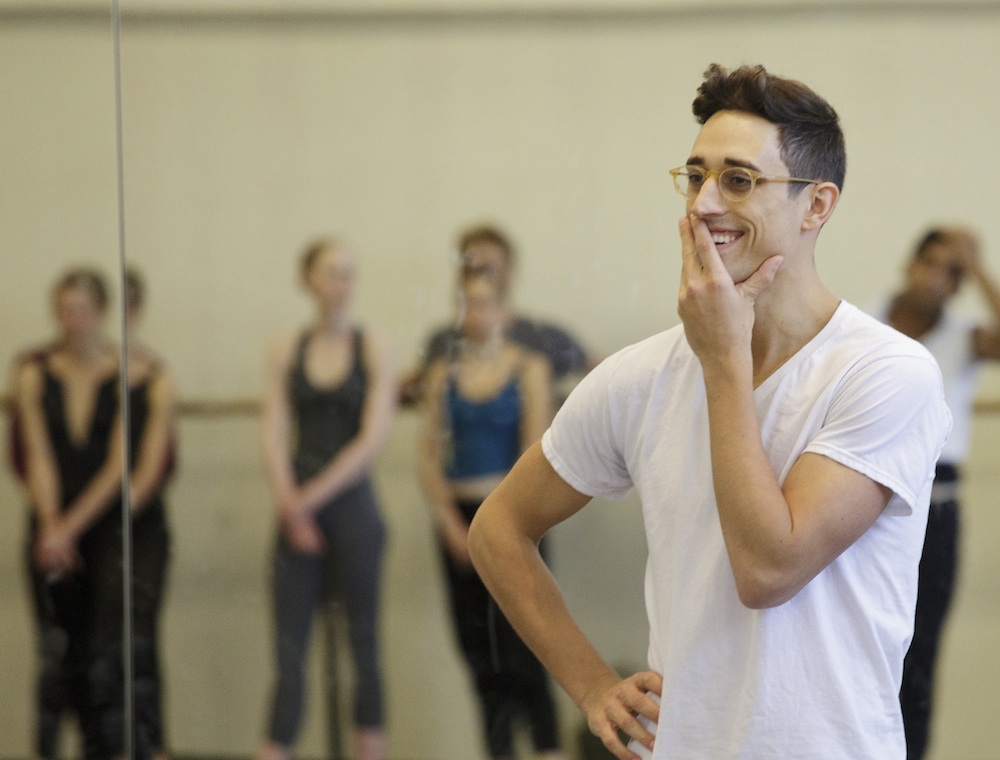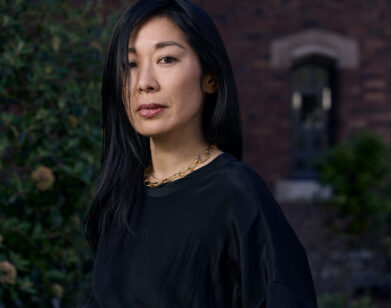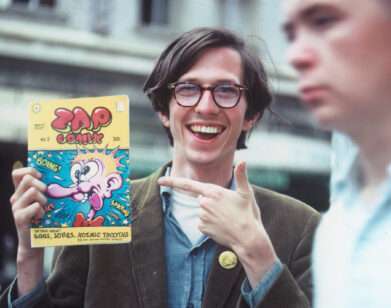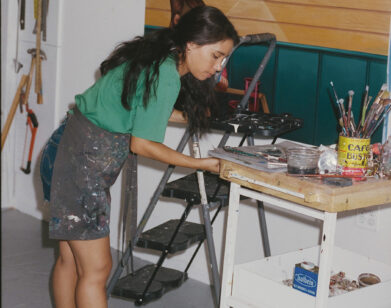Sufjan Stevens and Justin Peck in Motion
The only thing better than one massively talented artist at work is two in conversation, in whatever form that may take. (At Interview, we know a thing or two about this.) At the New York City Ballet, choreographer Justin Peck and singer-songwriter Sufjan Stevens have joined forces for a new work: The Decalogue, which premieres tonight at Lincoln Center’s David H. Koch Theater. Stevens composed the score, and Peck set it in motion with 10 dancers.
Both artists are well-versed in the art of collaboration. Peck—who has long been described as ballet’s rising star—is one of the most in-demand choreographers at work today. The 29-year-old is the Resident Choreographer of New York City Ballet, only the second person in the institution’s history to hold that title, and is the creative force behind 30 original ballets. In the past he’s worked with Opening Ceremony and Dior on fashion-meets-dance events. Sufjan Stevens, who’s worked alongside a myriad of musicians, and is long-revered for his own genre-fusing music, has never shied away from an interesting project. BQE, his cinematic and musical exploration of the Brooklyn Queens Expressway, which premiered at the Brooklyn Academy of Music in 2007, comes to mind.
The Decalogue is the pair’s third NYCB collaboration, following Year of the Rabbit (2012) and Everywhere We Go (2014). Both pieces were praised for breathing life into the formal traditions of ballet. Recently, Interview visited Lincoln Center to watch a Decalogue rehearsal. The dancers performed their first full run-through; stumbles and all, it was a remarkably realized piece of work, full of grace and energy. Afterwards, we spoke Stevens and Peck.
MATT MULLEN: Sufjan, this was your first time seeing the work. How did it feel?
SUFJAN STEVENS: It was exciting and weird. I’m familiar with Justin’s language, but there is stuff in here that I’m surprised to see. His way of breaking down the measures is really different than mine.
MULLEN: This is your first piano-only score. Why did you decide to go in that direction?
STEVENS: I wanted to simplify it, because the last ballet we collaborated on, Everywhere We Go, was a full orchestra and it was almost 40 minutes. It was kind of power pop and really, really dynamic and celebratory and unabashedly fun. This time around I wanted to be more pensive and more cerebral, and less explicitly harmonic and melodic. So I kept it with the piano because the piano lends itself to lots of harmonic discursions, and you can get away with a lot on it. A lot of the score is based on impromptu improvisations that I’ve developed over time. I collected about 50 of those ideas and spent maybe three weeks reducing it to the score that it is now. For Everywhere We Go I spent months, and it was really back and forth with Justin, who curated some of it, whereas this time around I finished the draft of the score, gave it to him, and it was maybe 80 percent there.
MULLEN: How was it different for you, Justin, coming in later to the process?
JUSTIN PECK: I can only really do it with someone that I trust, and I’ve worked a lot with Sufjan, so I felt comfortable going about it that way. It was kind of nice, actually, because you’re handed an entire ballet score and it’s like a Christmas morning present, getting to sit down and listen to it and get to know it. It was interesting to see Sufjan’s music take a step in a different direction, and I think it’s going to be something that people don’t necessarily expect, in a good way. I think it shows more range for what Sufjan can write, and there’s already so much range to begin with.
MULLEN: Sufjan described the music as more thoughtful and contemplative. How would you describe the movements?
PECK: I would say reverent. It has this post-modern or 20th-century ballet feel to it. I find little similarities to Paul Hindemith, especially the score he wrote for The Four Temperaments. It’s got an interesting structure and fluctuation. The ballet ends is the same way that it starts, which was Sufjan’s idea. There was this great moment when we made that in the studio—which was like, yesterday, by the way [laughs]—where it ends with them bowing towards Susan [the pianist]. We didn’t intend for that to happen, but the dancers were like, “Oh, look, we’re bowing towards the pianist.” It’s got this nice feeling of respect.
STEVENS: It does seem like this ballet is as much about the pianist as it is the dancers.
PECK: It’s been interesting to work with the music in the studio in relation to the choreography, because I feel like we’ve really bent it and stretched it out, and condensed things, and I think it’s shaped further because of what the choreographic demands are.
MULLEN: I want to go back a little. When did you first become aware of each other’s work?
PECK: I was a fan of Sufjan since I was in school here. I always loved his orchestration, the way he assembles songs, and in the back of my mind I thought it would be great music for dance. And then I don’t think Sufjan was aware of my work because I was just starting out; Year of the Rabbit was one of my first projects that I ever worked on as a choreographer. We had a mutual friend who introduced us. She put us together and encouraged us doing something.
STEVENS: You actually emailed me a letter that was kind of a formal solicitation to collaborate.
PECK: But that was probably a couple years before that.
STEVENS: I ignored it. I got so many solicitations. I was touring at the time, and I didn’t really know anything about ballet. I wouldn’t do this unless he asked me to; this is not my day job. But I’m really excited about it and I love doing it.
MULLEN: I read something where you described writing for ballet as a liberating experience, because the narrative is removed. Is that still the case?
STEVENS: Yes. I think there’s a lot that I can create that isn’t affiliated with songwriting or narrative, that can reside in its own abstract world, just tones and sounds and textures. So dancing’s really appropriate for it. It’s nice to have that kind of platform, because unlike modern dance or contemporary dance or downtown dance, ballet is formalized, and there’s something orthodox about it that I like. I like that there’s less emphasis on subversion and innovation. I actually think that my musical vernacular or my musical voice is also less inclined toward innovation and subversion. I think I’m a traditionalist.
PECK: I think it’s also about a focus on craft.
STEVENS: Maybe that’s what I’m trying to say. There’s nothing cutting edge about what I’m trying to do. I’m not creating a new sound. I’m not like Bjork, who’s an alien from another world. I’m of the earth. You could extract any measure of music out of anything I’ve ever done and you could find its affiliations in music history. I started on the oboe and had a disciplined and structured education playing in wind ensembles and orchestras and quintets. That informs some of what I do.
MULLEN: Justin, do you feel the same way with dance?
PECK: Yeah, for me it’s that combined with the personal touch of an individual. Just like Sufjan takes a lot of influences, but then he maintains his own voice because he is who he is.
MULLEN: Who are your dance influences?
PECK: Balanchine is the number one influence for me. His work was really musically driven. He and Jerome Robbins were the ones who really showed me that dance could be about the inner-relation between movement and music. When I was a student first seeing their work I was like, “Oh, this is a thing?” Because I grew up in San Diego, and there’s almost no dance scene there. So I never saw anything worthwhile when I was living there. I saw Giselle once, which is a big, old story ballet. But when I moved to New York it was this big eye-opening experience for me. The possibilities are endless.
THE DECALOGUE PREMIERES TONIGHT, MAY 12, 2017, IN NEW YORK CITY AT THE DAVID H. KOCH THEATER. TO PURCHASE TICKETS, CLICK HERE.







